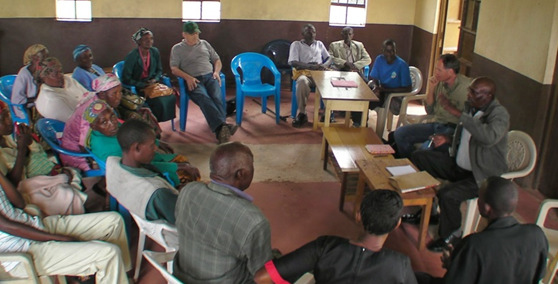
Wallace used to walk 10 kilometers to find water in the dry season. Margaret recalled that often she would go to sleep at night not knowing where she would go to look for water in the morning. Their animals were dying in times of drought. Lois said that it is a miracle that the Ngaamba people met the Hillcrest CRC people who helped them so much with drilling a well, getting a generator and pump, and having water!
It seems that many times the long-term impact of support from congregations in the U.S. and Canada goes untold. I think of all of the work groups and friendships that were made by Trinity CRC after Hurricane Mitch in Honduras. I think of the Foods Resource Bank growing project by Oakland CRC and the multiplication impacts that is having in Cambodia. I think of the way that Neland Avenue CRC has supported me, Davis Omanyo, and many others in work around the world.
It had been nearly 10 years since I last visited Ngaamba. With Hillcrest and Ngaamba we had a partnership: we shared the work of planning, fundraising, and building a water system. The Hillcrest people did their part, and the Ngaamba people have lived up to their commitments! They dug the pipe trenches, they collected water fees for maintenance, and their trained mechanic services the pump and generator. The Ngaamba people have also received financial grants from their political leaders to complete a couple of short extensions of the water lines. There are still members at the outer edges of the community who have to walk a long way to the water tanks to get water.
When I visited Ngaamba in Kenya for the first time in a decade, the people proudly showed us the well site, the generator house, and one of the distribution tanks.
They are hoping that the government will soon run electricity to the village so that the generator won’t be needed for much longer “cause it’s getting hedgy.”
I also wanted to visit Ngaamba to find out if they still grow grain amaranth. Ngaamba is in a very dry part of Kenya, and the droughts there cause frequent failures of the maize and bean crops. That’s why we tried the drought-resistant, high-protein crop, grain amaranth. It was great to see that eight of the 15 members present in the church are still growing amaranth as a nutritional-supplement crop.
They have given the seed to many others who live in neighboring communities. They’ve also noticed how eating the porridge helps men, women, and children stay healthy—and that eating it especially helps people living with AIDS. Their recipe for cooking with amaranth is adding one part amaranth flour to three parts millet or corn flour. (Cook the corn flour first for about five to 10 minutes before adding the amaranth flour, and then add sugar, and maybe some cinnamon or other good stuJ to suit your taste.) By the way, Blake De Jong, from Neland Ave CRC, took the better pictures in this letter!
Thanks to all the congregations that support me and World Renew!
- For the way the Lord used Hillcrest, Trinity, Oakland and Neland CRCs to bless his multi-national people!
- For the way that the Ngaamba people come together to teach us that there is potential in working together.
- That our CRC congregations may remain united, by the grace of God, in the face of "worship wars" and divisive differences of opinion.
Tom Post
Team Leader
World Renew Asia
